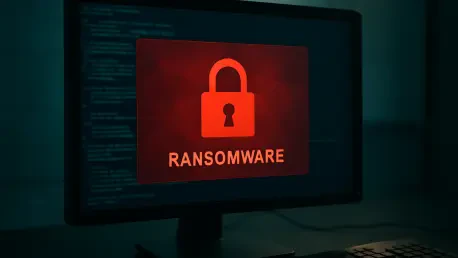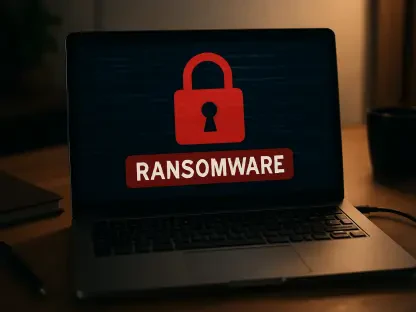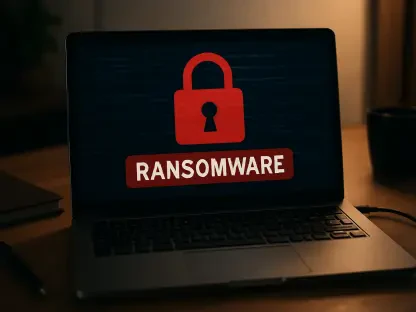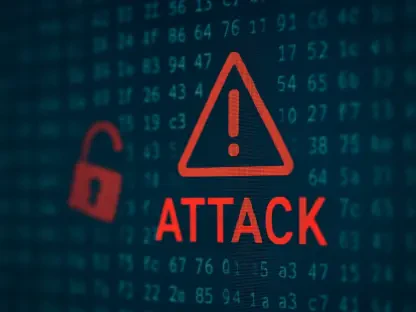In an era where digital infrastructure underpins nearly every facet of modern society, the rise of ransomware groups like Akira poses a staggering threat, with financial damages nearing $245 million and over a thousand known victims globally. This sophisticated ransomware-as-a-service (RaaS) operation has swiftly evolved into a top-tier cyberthreat, targeting not just small businesses but also critical sectors such as healthcare and manufacturing. The escalating danger lies in Akira’s ability to exploit virtual environments, disrupt multiple systems in mere hours, and leave organizations grappling with devastating consequences. This review dives deep into the tactics, techniques, and real-world impact of Akira, shedding light on why it demands urgent attention in the cybersecurity landscape.
Introduction to Akira Ransomware
Akira ransomware has emerged as a formidable player in the cybercrime ecosystem, operating under a ransomware-as-a-service model that allows affiliates to deploy its malicious tools for profit. Originating as a relatively underestimated threat, the group has rapidly transformed into a sophisticated operation, targeting a diverse range of victims from small enterprises to vital infrastructure sectors. Its ability to adapt and refine attack methods has positioned it as a critical concern for cybersecurity professionals worldwide, demanding a closer examination of its operational framework.
The significance of Akira lies in its strategic targeting of industries that underpin societal stability, such as healthcare and agriculture, where disruptions can have far-reaching consequences. Unlike many ransomware groups that focus solely on financial gain, this operation combines speed, innovation, and precision to maximize impact. As a result, understanding its mechanisms and evolution is essential for organizations aiming to bolster defenses against an ever-growing digital menace.
Core Tactics and Techniques of Akira
Rapid Data Exfiltration and Operational Speed
One of the defining characteristics of Akira’s operations is its exceptional efficiency in data exfiltration, often completing the process in as little as two hours. This rapid pace minimizes the window for detection, allowing attackers to extract sensitive information before organizations can respond. Such speed underscores the group’s focus on operational tempo as a key element of its success, leveraging streamlined processes to outpace traditional security measures.
The tools and methods employed by Akira to achieve this velocity include advanced scripting and automation, which enable swift identification and transfer of critical data. By prioritizing high-value targets within a network, the group ensures maximum leverage during ransom negotiations. This approach not only amplifies the pressure on victims but also highlights the need for real-time monitoring to counter such accelerated threats.
Moreover, the emphasis on speed reflects a broader trend among ransomware actors to reduce exposure time within compromised systems. Akira’s ability to operate under tight timelines poses a significant challenge for defenders, as conventional incident response frameworks often struggle to keep up. This tactic serves as a stark reminder of the importance of proactive threat hunting in today’s cybersecurity strategies.
Exploitation of Virtual Infrastructure
Akira has distinguished itself by pivoting toward virtual infrastructure as a primary attack vector, with a notable focus on platforms like Nutanix’s Acropolis Hypervisor (AHV). By targeting hypervisors and virtual machines, the group can disrupt multiple systems simultaneously, amplifying the scope of damage in a single strike. This shift marks a departure from traditional endpoint attacks, exploiting an often-overlooked area of organizational networks.
The significance of targeting lesser-known platforms like AHV lies in their widespread adoption among critical entities, coupled with relatively weaker cybersecurity defenses compared to more common hypervisors such as VMware ESXi. With Nutanix boasting over 27,000 customers globally, including key institutions, the potential for widespread disruption is immense. Akira’s strategic choice to exploit these environments reveals a calculated effort to capitalize on gaps in awareness and preparedness.
This focus on virtualization also complicates recovery efforts, as encrypted virtual machines can halt entire operational ecosystems. Organizations relying heavily on such technologies face heightened risks, as the cascading effects of a single breach can paralyze core functions. Addressing this vulnerability requires a reevaluation of security protocols specific to virtual environments, an area still underdeveloped in many sectors.
Use of Legitimate Tools for Malicious Purposes
Another hallmark of Akira’s methodology is the misuse of trusted commercial software, such as AnyDesk and LogMeIn, to carry out malicious activities. By leveraging these legitimate remote management tools, the group disables critical security mechanisms like firewalls and antivirus programs, effectively bypassing traditional defenses. This tactic blurs the line between benign and harmful activity, complicating detection efforts.
The exploitation of widely accepted tools poses a unique challenge for cybersecurity teams, as their usage often appears routine within network logs. Akira’s ability to repurpose these applications for nefarious ends highlights the dual-use nature of many enterprise solutions, necessitating stricter controls over access and monitoring. Such strategies reveal the group’s deep understanding of operational environments and their ability to exploit trust.
This approach also underscores a growing difficulty in distinguishing malicious intent from legitimate behavior in corporate settings. As ransomware actors increasingly adopt this method, organizations must invest in behavior-based analytics to identify anomalies in tool usage. Without such measures, the risk of undetected infiltration remains alarmingly high, further empowering groups like Akira.
Emerging Trends in Akira’s Operations
Recent developments in Akira’s approach point to a growing emphasis on virtual infrastructure as an underexplored attack surface ripe for exploitation. While the group historically targeted prominent hypervisors like VMware ESXi, its shift to platforms such as Nutanix AHV demonstrates an intent to probe less-defended territories. This trend signals a broader movement within the ransomware landscape toward virtualization environments, where security often lags behind other domains.
The strategic pivot to AHV, in particular, illustrates Akira’s adaptability in identifying and exploiting niche vulnerabilities. As organizations increasingly rely on diverse virtualization solutions to support digital transformation, the attack surface expands, offering new opportunities for cybercriminals. This evolution suggests that ransomware groups are keenly aware of industry trends and are quick to adjust their tactics accordingly.
Furthermore, the focus on virtual systems aligns with a broader industry challenge of securing complex, hybrid IT architectures. Many enterprises lack the specialized expertise or resources to adequately protect these environments, creating fertile ground for attacks. As this trend continues, it becomes imperative for cybersecurity frameworks to evolve, prioritizing virtualization as a critical area of defense.
Real-World Impact on Critical Sectors
Akira’s operations have had profound consequences for critical industries, including healthcare, manufacturing, and agriculture, where operational continuity is paramount. Attacks on these sectors often result in severe disruptions, such as halted medical services or interrupted supply chains, with ripple effects on public safety and economic stability. The targeting of such vital areas underscores the group’s intent to maximize societal impact alongside financial gain.
Specific instances, such as breaches involving Nutanix customers, highlight the tangible risks posed by Akira’s focus on virtual infrastructure. These incidents reveal how a single attack can incapacitate multiple systems, affecting not just the targeted organization but also downstream partners and communities. The stakes are particularly high in sectors where downtime translates directly into human or economic harm.
Beyond immediate operational losses, the long-term consequences include eroded trust in digital systems and increased regulatory scrutiny. Organizations in critical sectors face mounting pressure to enhance cybersecurity postures while grappling with the financial burden of recovery and ransom payments. This dynamic illustrates the broader societal cost of ransomware, extending far beyond individual victims to impact entire ecosystems.
Challenges and Limitations in Countering Akira
Mitigating the threat posed by Akira is fraught with obstacles, including systemic issues like delayed patching of known vulnerabilities, such as CVE-2024-40711 in Veeam software. Many organizations struggle to keep pace with updates, leaving exploitable gaps that ransomware groups readily target. This persistent lag in security hygiene remains a fundamental barrier to effective defense.
Additionally, inadequate monitoring of virtual infrastructure exacerbates the challenge, as many enterprises overlook these environments in favor of more traditional endpoints. Akira’s exploitation of this blind spot demonstrates the need for comprehensive visibility across all network layers, a capability that remains elusive for numerous organizations. Without such oversight, detecting and responding to intrusions becomes a near-impossible task.
Regulatory and operational hurdles further complicate efforts to counter Akira, as the group’s adaptability outstrips many existing frameworks. While authorities and industry bodies continue to issue advisories and update indicators of compromise, the rapid evolution of ransomware tactics often renders such guidance reactive rather than preventive. Strengthening defenses requires a coordinated, forward-thinking approach that anticipates future shifts in attacker behavior.
Future Outlook for Akira Ransomware
Looking ahead, Akira is likely to refine its tactics further, potentially targeting additional virtualization platforms beyond current focuses like Nutanix AHV. As emerging technologies reshape IT landscapes, the group may explore new vectors, such as cloud-native environments or IoT ecosystems, to exploit uncharted vulnerabilities. This trajectory suggests an ongoing escalation in the sophistication of ransomware threats.
The long-term implications for cybersecurity practices are significant, particularly in the realm of critical infrastructure protection. Organizations may need to prioritize specialized defenses for virtual environments, integrating advanced monitoring and rapid response capabilities. Failure to adapt to these evolving challenges risks perpetuating the cycle of disruption and financial loss that defines ransomware’s impact.
Moreover, the broader industry must contend with the possibility of Akira leveraging automation or artificial intelligence to enhance operational efficiency. Such advancements could further compress attack timelines, making prevention even more daunting. Preparing for these potential developments demands investment in cutting-edge research and cross-sector collaboration to stay ahead of cybercriminal innovation.
Conclusion and Key Takeaways
Reflecting on the examination of Akira ransomware, it is evident that this group has established itself as a leading cyberthreat through relentless innovation and strategic targeting, amassing nearly $245 million in ransoms and affecting over a thousand victims. Its impact on critical sectors and exploitation of virtual environments have exposed significant gaps in global cybersecurity readiness. Moving forward, organizations need to prioritize robust security measures tailored to virtualization platforms, ensuring comprehensive monitoring and swift patching of vulnerabilities. Collaboration between industry and government bodies should be strengthened to develop predictive strategies against evolving ransomware tactics. Ultimately, investing in advanced threat intelligence and fostering a culture of proactive defense offers the most viable path to mitigating the enduring menace of groups like Akira.









